We had a plan. Or someone came up with a plan. I don’t exactly remember being consulted about the plan. But I was amenable to the plan.
We left Hesperia on Sunday and drove down I-215 and I-15, through Moreno Valley and Temecula Valley to San Diego. That route passes right by (almost) San Diego Zoo’s Wild Animal Park, which is just a bit east of Escondido, so the plan was to stop there on the way to our temporary headquarters in SD’s Hotel Circle. We purchased tickets that allowed us access to all three venues (the Wild Animal Park, the San Diego Zoo, and Sea World) for five days, though we weren’t planning to stay that long.
It was hot. Africa hot. Which I’m sure the African animals appreciated. I didn’t.
PS: That’s a Javan rhinoceros (aka unicorn) to the left. The hint about why it is included here is inside.
[22 photos included]
Note to future visitors: The tram tour is problematic. The map they give you which makes everything seem compact doesn’t include the tram tour area. So you have to walk quite a ways to where it starts…all down hill. Then you stand in line for about an hour for a 25 minute tour which deposits you where it started. Then you get to walk back, uphill all the way.
Did I mention it was Africa hot? Pay the $10 bucks extra for priority seating so you don’t have to get the heat prostration. We didn’t pay it, I guess in solidarity with those who couldn’t afford it. Purchasing “cuts” just seemed too outrageous. We regretted it.
But we got pictures. And I’ve assembled them below, with a few stories to go with. We also got too worn out and hungry to visit most of the other exhibits. So…sorry. No lions or elephants. 🙁
On the other hand the horned animals we did see were not available for viewing at the zoo, which is currently turning the former horned animal exhibit area into a very large elephant exhibit.
We were greeted by a couple of birds. The first one looked too much like a vulture for my comfort. The second one looked like it was chewing on a rubber band. It was not. That’s part of his attractiveness.
 |
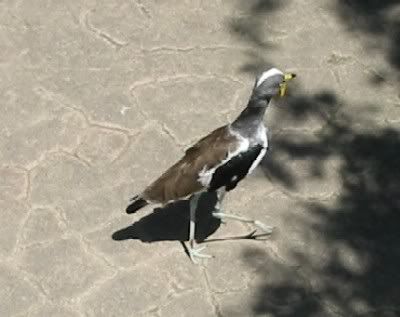 |
Around the bend, as we walked toward the Valley of Pain, were some African flamingos, which are distinguishable from their Caribbean relatives by their color, which is generated by their diet. Caribbean flamingos are pink because they love shrimp.
We also visited the kraal, where baby animals live part of the time. They were displaying young antelopes when we passed by. I think I spot a couple of springbok towards the front (could be gazelles, though), on either side of a blackbuck, a gerenuk in the middle back, and a steenbok second-back on the left. I’m less certain about the other one.
 |
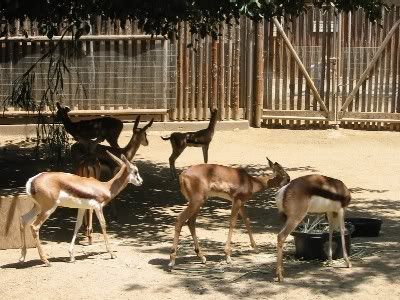 |
The cheetah was separated from the animals which it would normally consider consuming. Next door to the cheetah was a black rhinocerous I could only see the top of since he was down in his waterhole.. About 3600 black rhinos exist in the world.
 |
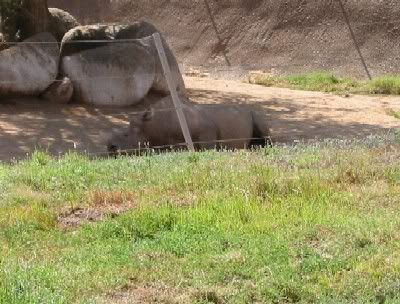 |
The photos below show various antelope species. I haven’t learned the names of them all. But being individually unidentifiable, nondescript even, is basically their defense strategy. It seems to have worked with me.
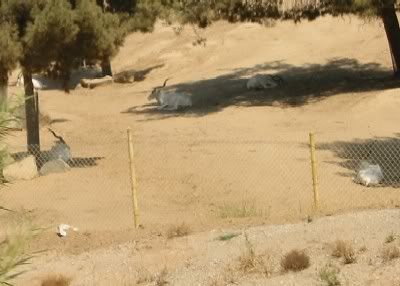 |
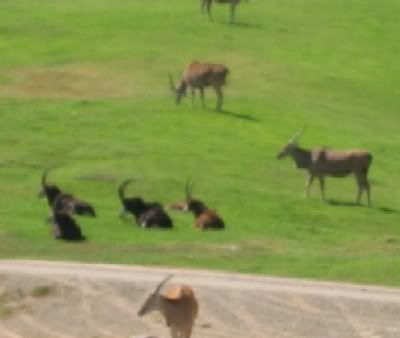 |
A solitary cape buffalo rests in the shade. The ostrich may be ignoring its eggs. More on these animals later? Perhaps.
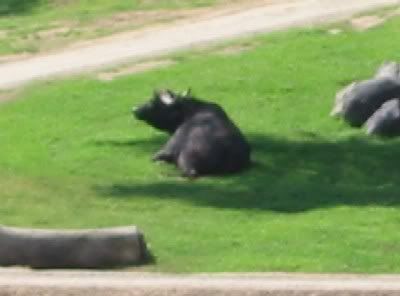 |
 |
Below are white rhinocerotes (I checked: that is indeed the plural). The northern white rhinoceros may be extinct, except for those in zoos worldwide…which may number as few as 9. The southern white rhino (and that really should be “wide rhino,” but English people hear the Africaans word for “wide” as “white”) is the most numerous of the second most massive land animal in existence. There are roughly 14,500 white rhinos on this planet.
There are 5 species odd-toed ungulates in the family Rhinocerotidae. Three of them, including the black rhino (which isn’t really black, but is called that to distinguish it from the white rhinos) and also the Javan one-horned rhino and the Sumatran two-horned are critically endangered, which means that if we don’t act now, they will be extinct in 15 years. The Indian rhino is endangered. The white rhinos are threatened.
One of the problems with breeding white rhinos in a zoo is that it takes the co-consent of two females. The females raise their children together and take turns guarding them and foraging. If you only have one female, she will refuse to participate. In the photo to the right, the two rhinos in the back are females and, we were told, nearly inseparable. I don’t know about their mating history.
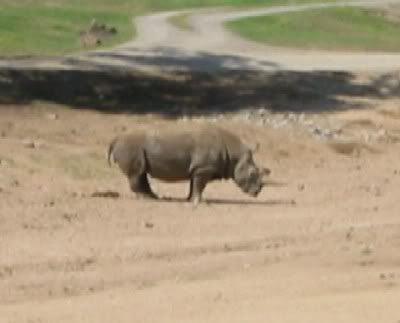 |
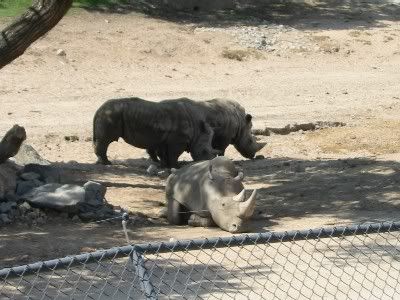 |
I am extremely disappointed to have missed the opportunity to get a photo of the unicorn when we passed it, being on the wrong side of the tram when it almost hit a snake crossing the road.
The oryx is a strange creature, with stripes on its face to make its horns seem longer than they are. The horns are not used defensively, but rather to attract possible mates. Apparently size matters.
A young giraffe was gamboling towards us. They can move quite rapidly, which may explain the slight blurriness.
 |
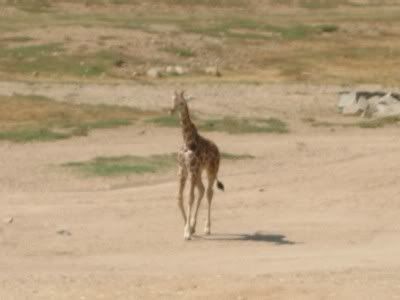 |
A springbok cropped the grass, but there was a surprise around the next bend. We happened by the blackbuck at a perfect time: an infant was nursing from its mother. 🙂
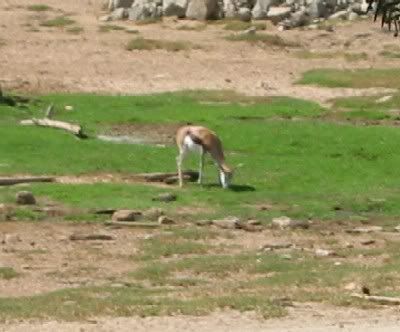 |
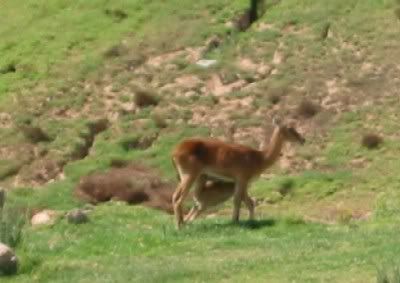 |
The pelicans formed a committee of three. The zebras were in a pen, though they seemed to be free to leave. Their stripes were quite narrow and I didn’t have the lens necessary to keep the stripes from smearing into a field of gray. Oh, well.
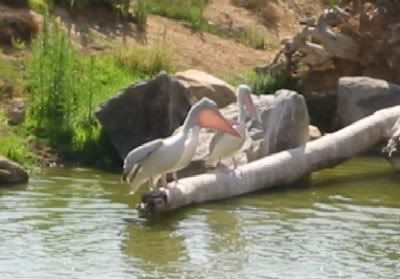 |
 |
We thought it strange that the ostrich eggs seemed to be completely unattended. Further down the hill was a group of buffalo. Buffalo hierarchy is such that the more important buffalo are in the middle. It’s safer there. This is not unlike humans, where outsiders are constantly under threat.
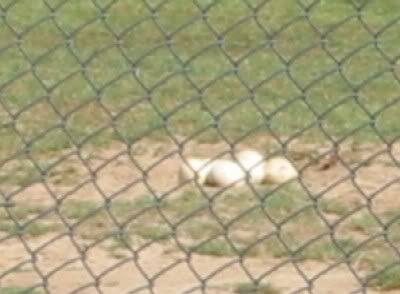 |
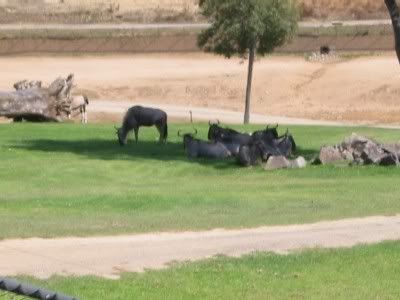 |
I pulled the crested crane out of its place in the proper rotation to the end, since it is also the case that we saw one tending eggs as we were leaving the park, hot, tired, perhaps broken. The national bird of Uganda is an elegant bird and apparently quite picky. The female with the eggs moved them around, sat on them, found them uncomfortable, and repeated this process at least three times.
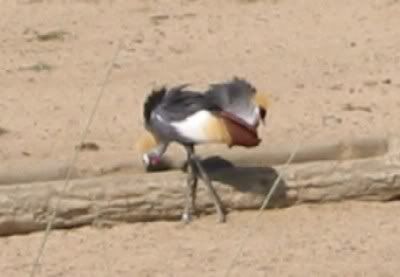 |
 |
We hit the road for San Diego, stopping for a meal in some part of it with lots of storage available…maybe Miramar, and landed in the hot tub for a long soak. Later we discovered they had just blown up their wifi. It came back online sometime Tuesday morning, as I recall…though I had to sit outside near the parking lot in order to get on.
Next stop was an all day trek in the zoo. It was still going to be Africa hot.

8 comments
Skip to comment form
Nothing much to say, just this was really a great read and the pics are wonderful.
You can do as many of these essays as you like and I’ll be happy to read them all.
Thanks, Robyn.
Author
…and then decided to scoop up some sounds:
Thank you for this one and the others, as well!
A pleasure!
Great shots. I have a love/hate thing for zoos, but as you say, if they can make people remember how important saving diversity is, it may make it worth the animals freedom.
But god, I love to see the animals. (Great title btw!)